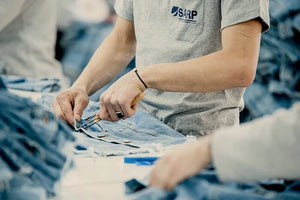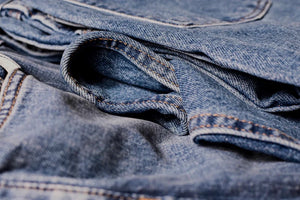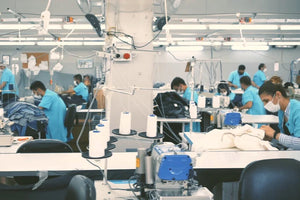Sustainable jeans production
Jul 14, 2019
The journey to the finished blue jeans in the store is long. There are many steps involved from growing the cotton to delivering the final product. These are usually characterized by a high burden on natural resources. At TORLAND, we make sure that these resources are conserved as much as possible.
In this article we describe the most important steps, which are summarized in the following table:
| Work step | Procedure at TORLAND | Impact on the environment |
| Cultivation of cotton | Certified organic farming, i.e. use of biological means for fertilization and pest control | Reduced water consumption and soil conservation, protection of biodiversity and the local population |
| Spinning, dyeing and weaving | Certified processing avoiding any substances that are toxic to humans and the environment | No harmful substances in our denim fabrics |
| Sewing, washing and finishing | Application of ethical standards regarding working conditions, occupational safety and the environment and avoidance of environmentally harmful processes | No health risks for employees and avoidance of toxic substances in the wastewater |
| transport | Sourcing and processing of all raw materials in the same country | Significant reduction in CO2 emissions |
Water consumption and environmental impact of cotton cultivation
The impact on the environment begins with the cultivation of cotton. The cotton plant requires a large amount of water to grow. The plant's consumption depends heavily on the quality of the soil. The healthier and more balanced the soil, the less water the plant needs.
Unfortunately, cotton is often grown in areas with few water resources, for example in Uzbekistan, parts of the USA, India or China. Often, remote water resources have to be used to irrigate the cotton fields. This changes natural river courses and removes water from the landscape. In such countries, peak quantities of up to 25,000 litres of water are needed per kilogram of cotton. The use of chemical fertilizers is another environmental burden. Their use leads to salinization of the soil, so that it no longer has a balanced environment. More water is therefore needed to successfully grow cotton again. The high use of pesticides affects the quality of the soil, water and air. Numerous organisms fall victim to the use of these chemicals.
At TORLAND we only use organically grown cotton . Only natural means of fertilization and pest control are permitted for this form of cultivation. All environmentally harmful substances are prohibited. In organic farming, cotton is usually grown in mixed crops that are less susceptible to pests. This protects the soil and allows a thicker layer of humus to develop, which means less water is needed for cultivation. Our article The difference between organic cotton and conventional cotton lists many other advantages of organic farming.
Dyeing and processing into cotton yarn
We love the dark blue color of our classic blue jeans! This color is created through a multi-stage processing process that normally requires the use of numerous chemicals. Before the cotton is dyed, residues on the cotton fibers are removed. The cotton is then processed into yarn and dyed. Indigo dye is used for this, which is either extracted from plants or produced synthetically.
Due to the high demand for indigo, the synthetic process was developed in the 19th century. It is exactly the same substance as plant-based indigo. The synthetic process is no more harmful to the environment than plant-based extraction if harmful chemicals are not used.
At TORLAND, we only use substances that are harmless to humans and the environment to produce indigo dye. The manufacturing process, from growing the cotton to weaving the fabric, which includes dyeing, is subject to a strict certification process. Many of the chemicals otherwise used in conventional textile processing are prohibited, such as harmful solvents, plasticizers, heavy metals, nanoparticles or genetically modified organisms.
|
Cotton is spun into yarn (Image: Nic McPhee , Flickr, CC BY-SA 2.0 ) |
The yarn is dyed (Photo: James Chen , Flickr, CC BY-SA 2.0 ) |
Further processing until the finished jeans
The cotton yarn is processed into denim using large weaving machines. A special feature of denim is that three colored lengthwise threads are woven with one undyed crosswise thread. This gives the denim its special look. The individual pieces are then cut from the fabric, sewn together to form the finished jeans and provided with all the accessories such as buttons, rivets, labels, etc. A pair of jeans consists of up to a hundred individual pieces!
While the further processing of the denim fabric is far more environmentally friendly, production often ends with very environmentally damaging methods, known as finishing. Depending on the model, the jeans are individually processed again to give them the desired "used look". These are artificially created abrasions and even holes. This gives the impression that the jeans have already been worn several times. Very aggressive bleaching chemicals or harmful mechanical processes are often used for this, which can leave residues in the respiratory tract.
But there is another way. At TORLAND we only use processes that have a low impact on the environment. In most cases we do not post-treat the jeans at all, or we use modern alternatives such as laser treatment or ozone whitening. Many of our jeans are treated with stonewashing to give them a modern look. The jeans are washed in special machines with lava stones. Since our jeans do not contain any harmful chemicals, no harmful substances can get into the wastewater.

Jeans washing machines with lava stones (Image: Sascha Hümbeli)
Transport of goods
In the textile industry, raw materials and starting materials are usually transported many kilometers to the country of production. It is not uncommon for these goods to come from many different countries (e.g. cotton from Pakistan, buttons from China, leather from India). Intermediate products are also often transported from production site to production site (e.g. weaving denim in Spain, sewing jeans in Bulgaria, washing jeans in Romania, finishing in Bulgaria again). It is not uncommon for even organic products to be manufactured in this way. However, resource-saving production also includes avoiding long transport routes.
At TORLAND, we make sure that all raw materials come from the same country, namely Turkey. Turkey has the advantage of growing its own cotton. We only use organic Turkish denim for our jeans. In addition, all additional products such as buttons, zippers and labels are made in Turkey, mostly within the textile region in Istanbul. This allows us to reduce transport routes to a minimum. Only the finished jeans are delivered from Istanbul to us in Austria.*
* The CO2 emissions of TORLAND jeans were analyzed in September 2019. For 2019, emissions of 32.1 GHG (tons of CO2 equivalent) per year were determined. This includes the entire process chain from the cultivation of the cotton to the production and use of the jeans to the end of the life cycle (disposal of the jeans). About half to two thirds of the emissions are due to the use of the jeans by consumers.
Sources:






